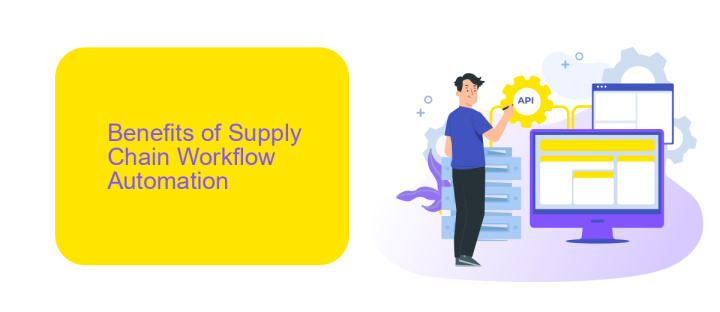Supply Chain Workflow Automation
In today's fast-paced business environment, Supply Chain Workflow Automation is revolutionizing the way companies manage their operations. By leveraging advanced technologies such as AI and machine learning, businesses can streamline processes, reduce errors, and enhance efficiency. This article explores the key benefits of automating supply chain workflows and how it can drive competitive advantage in the ever-evolving market landscape.
Introduction
In today's rapidly evolving business environment, supply chain workflow automation has become a critical component for organizations aiming to enhance efficiency and reduce operational costs. By leveraging advanced technologies, companies can streamline their supply chain processes, minimize human error, and improve overall productivity. Automation not only optimizes routine tasks but also provides valuable insights through data analytics, enabling better decision-making.
- Reduction in manual errors
- Enhanced data accuracy
- Improved operational efficiency
- Cost savings
- Real-time tracking and monitoring
One effective way to achieve seamless supply chain workflow automation is through the integration of various systems and software. Services like ApiX-Drive facilitate these integrations by connecting different applications and automating data transfer between them. This not only reduces the complexity of managing multiple platforms but also ensures that information flows smoothly across the entire supply chain. By adopting such solutions, businesses can stay competitive and responsive to market demands.
Benefits of Supply Chain Workflow Automation

Supply chain workflow automation offers numerous benefits, significantly enhancing operational efficiency and reducing manual errors. By automating repetitive tasks such as order processing, inventory management, and shipment tracking, companies can streamline their operations, leading to faster and more accurate outcomes. This automation not only saves time but also allows employees to focus on more strategic activities, thereby boosting overall productivity and innovation within the organization.
Moreover, integrating various systems and processes through automation platforms like ApiX-Drive ensures seamless data flow across the supply chain. This integration helps in real-time monitoring and decision-making, enhancing visibility and control over the entire supply chain. With improved data accuracy and timely insights, businesses can better forecast demand, manage resources efficiently, and respond swiftly to market changes. Ultimately, supply chain workflow automation contributes to cost savings, improved customer satisfaction, and a competitive edge in the market.
Key Considerations for Automating Supply Chain Workflows

Automating supply chain workflows requires careful planning and consideration to ensure seamless integration and optimal performance. Key factors must be evaluated to achieve successful automation.
- Integration Capabilities: Ensure that the automation tools can integrate with existing systems. Services like ApiX-Drive can facilitate smooth data flow between different platforms.
- Scalability: Choose solutions that can scale with your business growth, accommodating increased data and process complexity.
- Data Security: Prioritize tools that offer robust security measures to protect sensitive supply chain data.
- User Training: Provide comprehensive training for staff to effectively use and manage the automated workflows.
- Cost-Benefit Analysis: Conduct a thorough analysis to ensure the benefits of automation outweigh the implementation costs.
By considering these factors, businesses can effectively automate their supply chain workflows, leading to increased efficiency, reduced errors, and improved overall performance. Leveraging integration services like ApiX-Drive can further streamline the process, ensuring a cohesive and efficient supply chain operation.
Challenges and Barriers to Implementation

Implementing supply chain workflow automation presents several challenges and barriers that organizations must navigate. One significant hurdle is the integration of new automation technologies with existing systems, which can be complex and time-consuming. Additionally, the high initial costs associated with automation tools and software can be a deterrent for many companies, especially small and medium-sized enterprises.
Another challenge is the resistance to change from employees who are accustomed to traditional workflows. This resistance can stem from a lack of understanding or fear of job displacement. Moreover, ensuring data accuracy and consistency across the supply chain can be difficult, as automation relies heavily on precise and reliable data inputs.
- Integration with legacy systems
- High initial costs
- Employee resistance
- Ensuring data accuracy and consistency
Services like ApiX-Drive can help mitigate some of these challenges by simplifying the integration process. ApiX-Drive offers a user-friendly platform that allows businesses to connect their existing systems with new automation tools seamlessly. By addressing integration issues, such services can significantly reduce the time and effort required to implement supply chain workflow automation.
Best Practices for Successful Implementation
Implementing supply chain workflow automation requires a strategic approach to ensure success. Begin by thoroughly analyzing your current processes to identify bottlenecks and areas for improvement. Engage stakeholders from different departments to gather insights and ensure the solution aligns with overall business objectives. Prioritize scalability and flexibility in your chosen automation tools to accommodate future growth and changes in the supply chain landscape.
Integration is a key factor in successful implementation. Utilize services like ApiX-Drive to seamlessly connect various systems and applications within your supply chain. This will facilitate real-time data exchange and enhance overall efficiency. Additionally, provide comprehensive training to your team to ensure they are well-versed in the new automated processes. Regularly monitor and evaluate the performance of the automation solution to identify any issues and make necessary adjustments. By following these best practices, you can achieve a smooth and effective transition to an automated supply chain workflow.
- Automate the work of an online store or landing
- Empower through integration
- Don't spend money on programmers and integrators
- Save time by automating routine tasks
FAQ
What is Supply Chain Workflow Automation?
What are the benefits of automating supply chain workflows?
How can I integrate different systems in my supply chain?
What types of processes can be automated in a supply chain?
Is it difficult to set up supply chain workflow automation?
Strive to take your business to the next level, achieve your goals faster and more efficiently? Apix-Drive is your reliable assistant for these tasks. An online service and application connector will help you automate key business processes and get rid of the routine. You and your employees will free up time for important core tasks. Try Apix-Drive features for free to see the effectiveness of the online connector for yourself.


